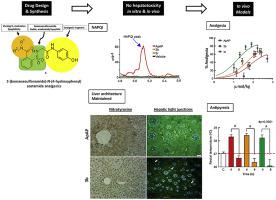European Journal of Medicinal Chemistry ( IF 6.0 ) Pub Date : 2020-06-30 , DOI: 10.1016/j.ejmech.2020.112600 Hernan A Bazan 1 , Surjyadipta Bhattacharjee 2 , Carolina Burgos 3 , Javier Recio 3 , Valentina Abet 3 , Amanda R Pahng 4 , Bokkyoo Jun 2 , Jessica Heap 2 , Alexander J Ledet 2 , William C Gordon 2 , Scott Edwards 5 , Dennis Paul 6 , Julio Alvarez-Builla 3 , Nicolas G Bazan 2

|
Although acetaminophen (ApAP) is one of the most commonly used medicines worldwide, hepatotoxicity is a risk with overdose or in patients with compromised liver function. ApAP overdose is the most common cause of acute fulminant hepatic failure. Oxidation of ApAP to N-acetyl-p-benzoquinone imine (NAPQI) is the mechanism for hepatotoxicity. 1 is a non-hepatotoxic, metabolically unstable lipophilic ApAP analog that is not antipyretic. The newly synthesized 3 is a non-hepatotoxic ApAP analog that is stable, lipophilic, and retains analgesia and antipyresis. Intraperitoneal or po administration of the new chemical entities (NCEs), 3b and 3r, in concentrations equal to a toxic dose of ApAP did not result in the formation of NAPQI. Unlike livers from NCE-treated mice, the livers from ApAP-treated mice demonstrated large amounts of nitrotyrosine, a marker of mitochondrial free radical formation, and loss of hepatic tight junction integrity. Given the widespread use of ApAP, hepatotoxicity risk with overuse, and the ongoing opioid epidemic, these NCEs represent a novel, non-narcotic therapeutic pipeline.
中文翻译:

一种新型的2-(苯磺酰胺)-N-(4-羟苯基)乙酰胺止痛药,其缺乏肝毒性并保留了退烧药。
尽管对乙酰氨基酚(ApAP)是全球最常用的药物之一,但过量或肝功能受损的患者都有肝毒性的危险。ApAP过量是急性暴发性肝衰竭的最常见原因。ApAP氧化为N-乙酰基-对苯醌亚胺(NAPQI)是肝毒性的机制。1是非退热的非肝毒性,代谢不稳定的亲脂性ApAP类似物。新合成的3是一种非肝毒性的ApAP类似物,其稳定,亲脂并保留了镇痛和退热作用。新化学实体(NCE),3b和3r的腹膜内或口服给药浓度等于ApAP的毒性剂量时,不会导致NAPQI的形成。与用NCE处理的小鼠的肝脏不同,用ApAP处理的小鼠的肝脏表现出大量的硝基酪氨酸(线粒体自由基形成的标志物)和肝紧密连接完整性的丧失。鉴于ApAP的广泛使用,过度使用引起的肝毒性风险以及阿片类药物的持续流行,这些NCEs代表了一种新颖的,非麻醉性的治疗途径。











































 京公网安备 11010802027423号
京公网安备 11010802027423号